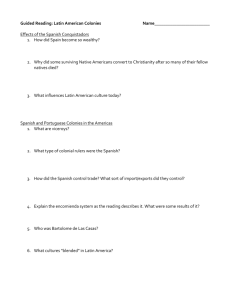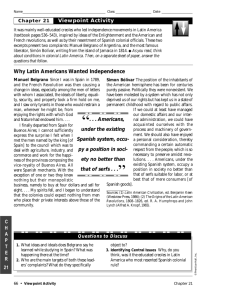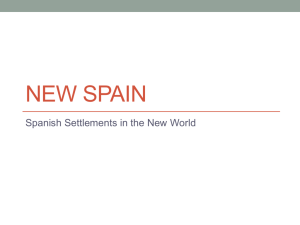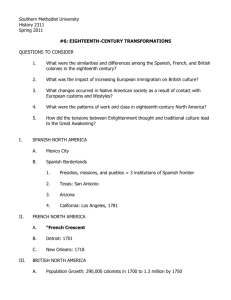Chapter 19 Review
advertisement
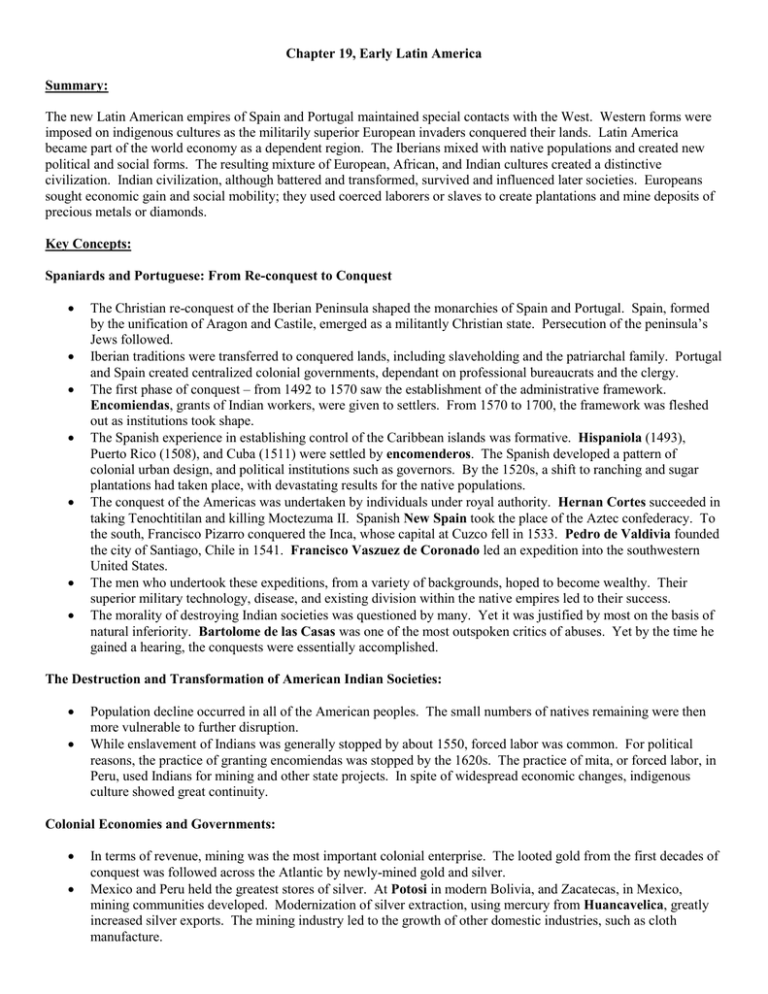
Chapter 19, Early Latin America Summary: The new Latin American empires of Spain and Portugal maintained special contacts with the West. Western forms were imposed on indigenous cultures as the militarily superior European invaders conquered their lands. Latin America became part of the world economy as a dependent region. The Iberians mixed with native populations and created new political and social forms. The resulting mixture of European, African, and Indian cultures created a distinctive civilization. Indian civilization, although battered and transformed, survived and influenced later societies. Europeans sought economic gain and social mobility; they used coerced laborers or slaves to create plantations and mine deposits of precious metals or diamonds. Key Concepts: Spaniards and Portuguese: From Re-conquest to Conquest The Christian re-conquest of the Iberian Peninsula shaped the monarchies of Spain and Portugal. Spain, formed by the unification of Aragon and Castile, emerged as a militantly Christian state. Persecution of the peninsula’s Jews followed. Iberian traditions were transferred to conquered lands, including slaveholding and the patriarchal family. Portugal and Spain created centralized colonial governments, dependant on professional bureaucrats and the clergy. The first phase of conquest – from 1492 to 1570 saw the establishment of the administrative framework. Encomiendas, grants of Indian workers, were given to settlers. From 1570 to 1700, the framework was fleshed out as institutions took shape. The Spanish experience in establishing control of the Caribbean islands was formative. Hispaniola (1493), Puerto Rico (1508), and Cuba (1511) were settled by encomenderos. The Spanish developed a pattern of colonial urban design, and political institutions such as governors. By the 1520s, a shift to ranching and sugar plantations had taken place, with devastating results for the native populations. The conquest of the Americas was undertaken by individuals under royal authority. Hernan Cortes succeeded in taking Tenochtitilan and killing Moctezuma II. Spanish New Spain took the place of the Aztec confederacy. To the south, Francisco Pizarro conquered the Inca, whose capital at Cuzco fell in 1533. Pedro de Valdivia founded the city of Santiago, Chile in 1541. Francisco Vaszuez de Coronado led an expedition into the southwestern United States. The men who undertook these expeditions, from a variety of backgrounds, hoped to become wealthy. Their superior military technology, disease, and existing division within the native empires led to their success. The morality of destroying Indian societies was questioned by many. Yet it was justified by most on the basis of natural inferiority. Bartolome de las Casas was one of the most outspoken critics of abuses. Yet by the time he gained a hearing, the conquests were essentially accomplished. The Destruction and Transformation of American Indian Societies: Population decline occurred in all of the American peoples. The small numbers of natives remaining were then more vulnerable to further disruption. While enslavement of Indians was generally stopped by about 1550, forced labor was common. For political reasons, the practice of granting encomiendas was stopped by the 1620s. The practice of mita, or forced labor, in Peru, used Indians for mining and other state projects. In spite of widespread economic changes, indigenous culture showed great continuity. Colonial Economies and Governments: In terms of revenue, mining was the most important colonial enterprise. The looted gold from the first decades of conquest was followed across the Atlantic by newly-mined gold and silver. Mexico and Peru held the greatest stores of silver. At Potosi in modern Bolivia, and Zacatecas, in Mexico, mining communities developed. Modernization of silver extraction, using mercury from Huancavelica, greatly increased silver exports. The mining industry led to the growth of other domestic industries, such as cloth manufacture. Indian traditional agriculture continued, along with the Spanish haciendas, rural estates. On the latter, crops such as sugar were grown for export. Although industries such as woolen cloth production made the colonies more self-sufficient, mining dominated the economy. Spaniards had the monopoly on trade with Spanish America. All trade passed through Seville, with its consulado, or merchant guild. Spain kept other nations out of its commercial sphere with galleons and the use of fortified ports such as Havana. In spite of the great wealth flowing into Spain, much of it flowed out to the rest of Europe. In any case, the revenue from taxation was greater. By the Treaty of Tordesillas in 1494, Spain and Portugal divided their conquests. Spain ruled its empire with the use of letrados, lawyers. The mass of colonial law was recodified in 1681 as the Recopilacion. The Council of the Indies governed the colonies from Spain through two viceroys. Their domains were further divided into 10 judiciaries each: the audiencias. The Catholic Church was a major component of rule. The religious orders were responsible for conversion and education, and sometimes for the protection of natives. The role of the orders was later assumed by the secular church hierarchy, controlled by the Spanish crown. European culture and thought was imported and disseminated largely through the church. Even offices of the Inquisition were established. Brazil: The First Plantation Colony: The Portuguese first reached South America in 1500, at Brazil, but the territory was ignored for decades. Portuguese nobles were granted captaincies, nearly autonomous domains. They were followed by Jesuits, and a series of coastal settlements grew up. Sugar can was by far the greatest commodity, demanding large amounts of capital and labor. A model plantation colony, Brazilian society started with white planters at the top, and ended with slaves. A governor-general represented Portuguese rule. Unlike Spanish America, Brazil was only part of the vast Portuguese rule. Unlike Spanish America, Brazil was only part of the vast Portuguese empire. Its dependence on Portugal was great, and the colony was slow to develop its own cultural life. European political developments were echoed in the colonies. Competition in Europe was also played out in the colonies. However, Portugal’s hold on Brazil was extended when Paulistas explored the interior. Gold strikes in the region of Minas Gerais led to a gold rush. Massive importation of slaves led to their making up half the population. By the mid-18th century, Brazil was the world’s greatest gold producer. Mining led to further development of the interior, and destruction of more native populations. Rio de Janeiro became the colony’s capital. Multiracial Societies: Three groups came together to form the complex Latin American society. Miscegenation, mixing of races, produced mestizos, who were neither native nor Spanish. The sociedad de castas – society of castes – used race, wealth, occupation, and place of birth to determine a person’s place in society. Attempts to sort out the new categories had practical implications, as legal restrictions were applied to different groups. Although at the top of the hierarchy, whites were also subdivided in to Spanish-born peninsulares and those born in the colonies: creoles. Considerations such as age, class, and gender carried over from Iberian traditions. The 18th Century Reforms: The intellectual climate of the Enlightenment had its impact on the colonies. Clubs of amigos del pais met to discuss reform. Spain’s hold on its colonies was threatened by piracy and the competition of other European nations. Spanish oversight of its colonial systems flagged, leading to corruption and loss of revenue. The War of the Spanish Succession, resolved by the Treaty of Utrecht in 1713, opened the Spanish trading empire to France and England. The Bourbon reforms of Charles III and his successors revived Spanish control of the colonies. The reforms did not recast the colonial structure, but sought to make it more effective. Jose de Galvez investigated the administration of Mexico before taking over as minister of the Indies. He created a system of intendants that made the administration more effective. The loss of Florida and Havana led Spain to strengthen the colonial militia. Grants of monopolies increased the government’s control over key commodities. Trade was opened to other nations, leading to a boom in some areas, such as the Buenos Aires ranching industry. However, some areas experienced economic decline. In the long run, the reforms led to widespread dissatisfaction as groups, such as creoles, lost their place in the government. Under the Marquis of Pombal, similar reforms were carried out in Brazil. He followed the English model of mercantilism, to make good the revenue loss due to declining gold production. He granted monopolies to develop agriculture, and the region of the Amazon in particular. To people the area, he encouraged mixed marriages. His reforms were only partially successful. Population growth in Latin America went along with exploitation of new areas and a higher volume of exports to Europe. Latin American society, disrupted by the reforms of the Bourbons and Pombal, was in ferment. The Comunero Revolt of 1781 nearly ended colonial rule in New Granada. The native rising of Tupac Amaru in Peru took three years to suppress. Brazil, on the other hand, experienced no major revolts. Deep divisions in colonial society made unified protest unlikely. Key Terms: Sociedad de Castas Peninsulares Tupac Amaru Charles III Viceroyalties Habsburg Monarchy Creoles Hernan Cortez Encomiendas New Spain Essay Questions: Early Latin America 1. In what sense can it be said that the nature of the Latin American colonies was simply a reflection of Iberian society? 2. Compare and contrast the colonial economies of Spanish America and Brazil. 3. How was the society of the Latin American colonies organized? What determined the social hierarchy? 4. What was the intent of the Spanish reforms of the 18th century? To what extent were they successful?
